Three GeForce GTX 780 Graphics Cards Reviewed

Let’s meet three Hi-End graphics cards with proprietary designs that use the same graphics processor inside. Today we will talk about products from EVGA, Gigabyte and Inno3D, as well as sum up all.
We continue our reviews of original GeForce GTX 780 graphics cards. Recently we’ve tested products from MSI and Palit, and today we are going to check out three more, manufactured by EVGA, Gigabyte and Inno3D. We’ll benchmark their performance but will focus on the efficiency and noisiness of their cooling systems. We’ll also examine their overclocking potential and sum up all the information we’ve gathered in our recent reviews of GeForce GTX 780s.
Technical Specifications and Recommended Pricing
We are going to compare the technical specifications of the two graphics cards reviewed today side by side with the reference GeForce GTX 780:
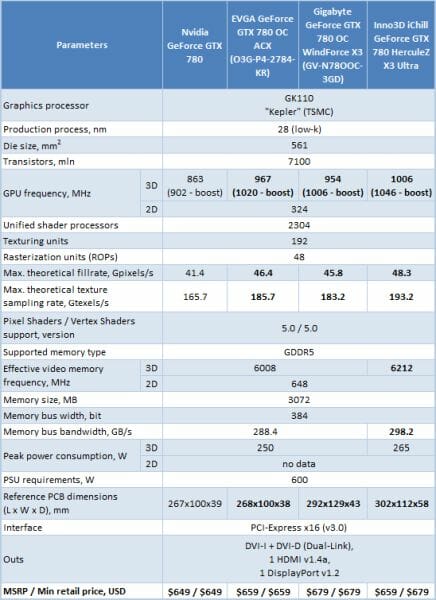
Testing Participants
EVGA GeForce GTX 780 Superclocked ACX 3GB (03G-P4-2784-KR)
EVGA Corporation offers as many as eight GeForce GTX 780s to everyone’s taste and budget. We can hardly name any other manufacturer that provides such a broad choice of Nvidia’s top-end graphics cards. The eight models differ in clock rates and even cooling systems, among which we can find two with waterblocks for liquid cooling. EVGA’s product range keeps on evolving, by the way. Recently the company has announced a number of GeForce GTX 760 and 780 products with dual BIOS. We haven’t yet got one, but the EVGA GeForce GTX 780 Superclocked ACX 3GB (03G-P4-2784-KR) is quite an exciting model in its own right.
Its key features are indicated on the front of its rather compact box. For detailed descriptions you can refer to the back of the packaging.
There is a small window in the box so that you could check out a sticker on the card and make sure it is the product you need rather than something else.
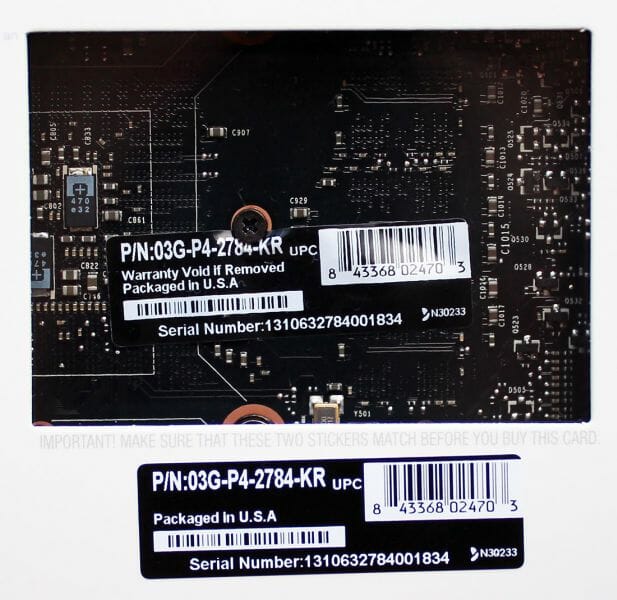
The accessories are numerous, including two manuals (brief and full versions) and various stickers:
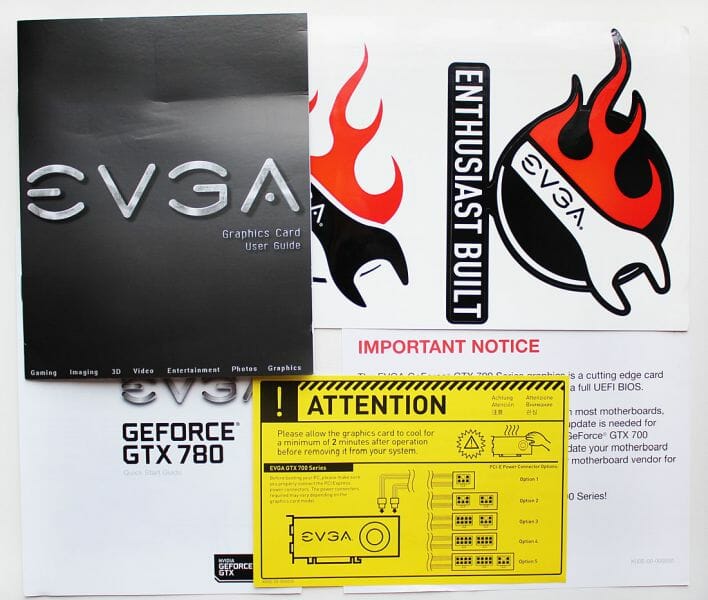
Then, in three individual packs, there are two power adapters, a DVI->D-Sub adapter, and a software CD:
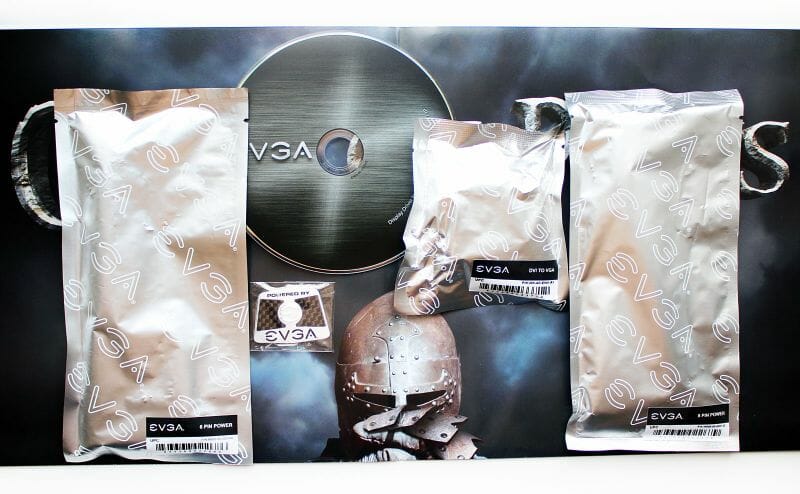
A huge EVGA Gaming poster is included with the product. You may want to hang it above the computer case with your new EVGA graphics card inside.
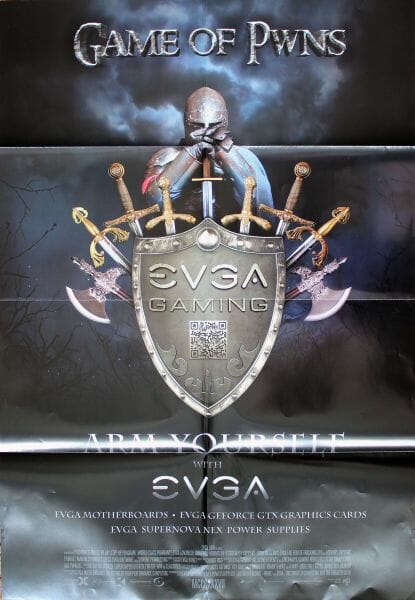
The accessories are added in the USA, although the card itself is manufactured in China. It costs $659, which is a mere $10 more than the recommended price for GeForce GTX 780s. Its warranty period is 3 years.
The EVGA GeForce GTX 780 Superclocked ACX is compact (268x100x38 mm) and beautiful. The plastic cooler casing is painted a matte paint with grainy texture, which looks splendid together with the two glossy fans.
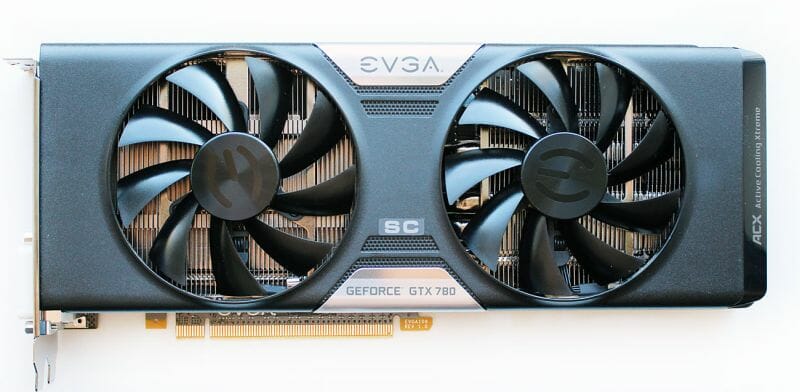
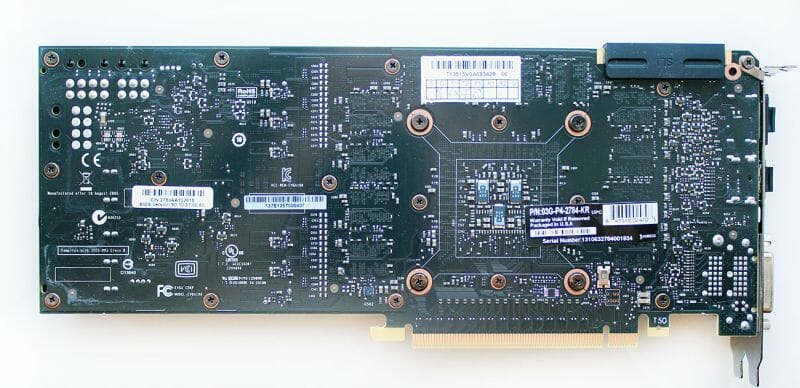
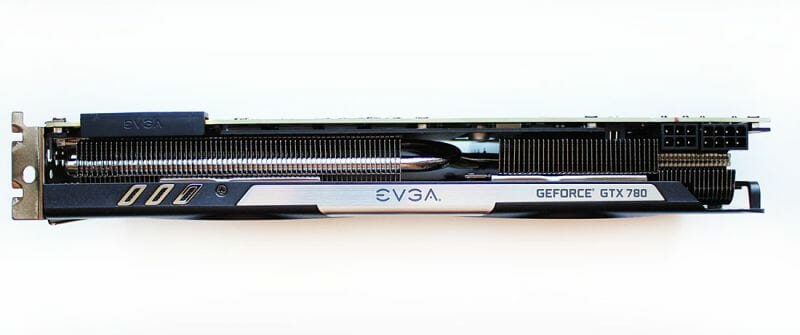
As additional touches that contribute to the exclusive exterior of the product, there are the gold-colored inserts with manufacturer and model names, the figured grid imitations, the lacquered edging with the name of the cooling system, and the chrome-like plastic inserts on the top of the casing.
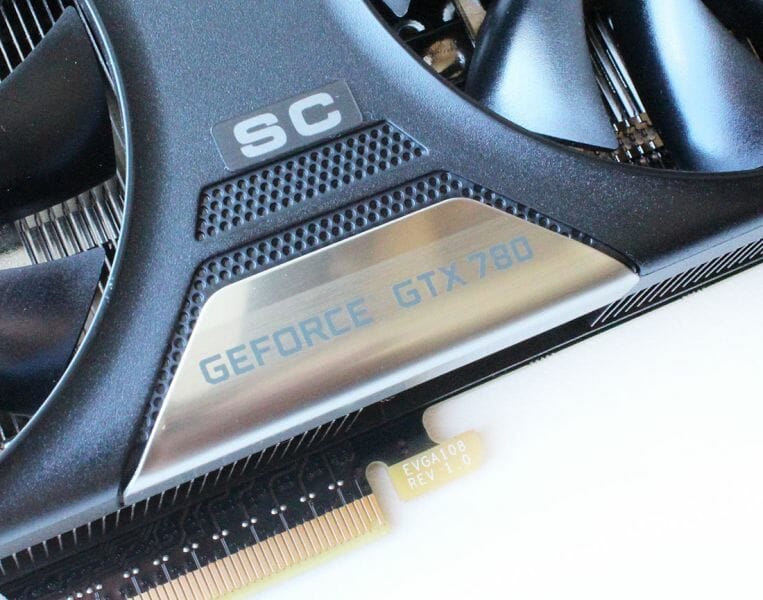
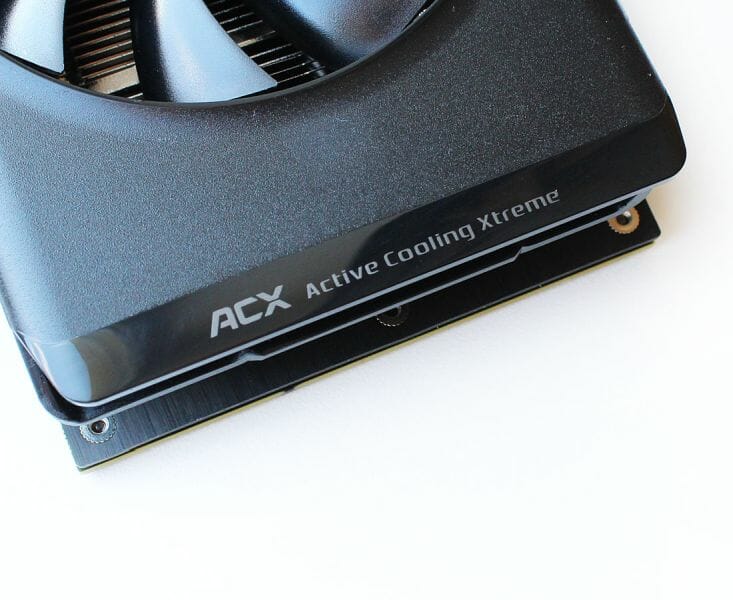
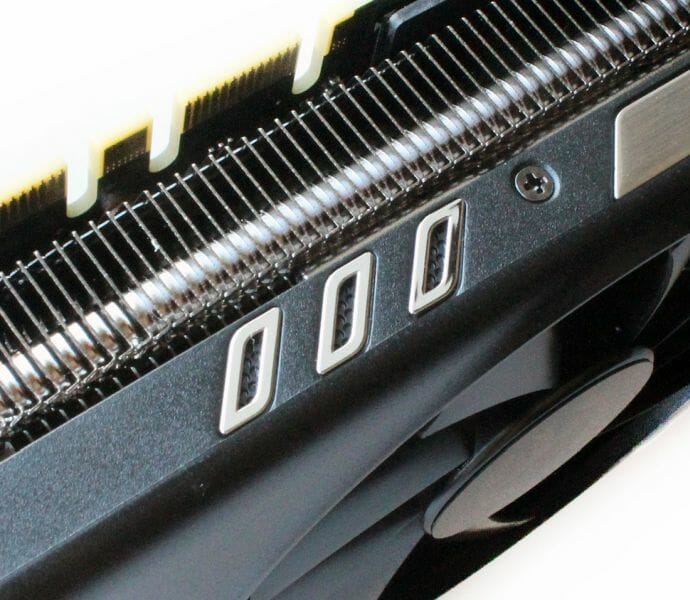
With all these embellishments, the EVGA GeForce GTX 780 Superclocked ACX is one of the most aesthetically pleasing devices in the top-performance category.
We’ve come to expect original solutions from EVGA, even when its products are based on reference designs. Here, we can see an enlarged vent grid in the card’s mounting bracket.
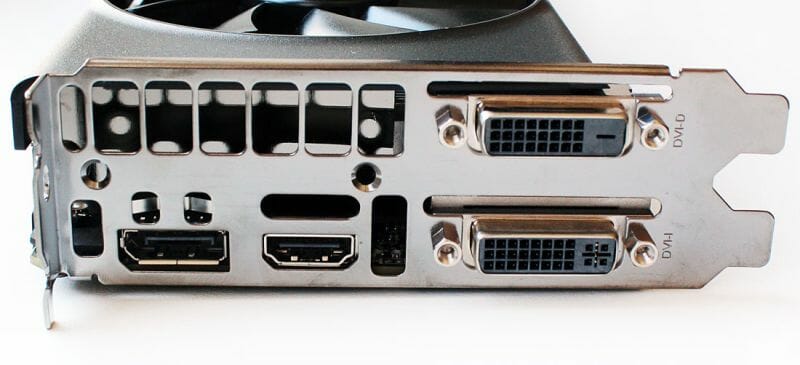
The selection of video interfaces is standard with dual-link DVI-I and DVI-D ports, an HDMI 1.4a port, and a DisplayPort 1.2. The power and SLI connectors are standard as well and can be found in their conventional locations. They are easily accessible, unlike on MSI cards, for example.
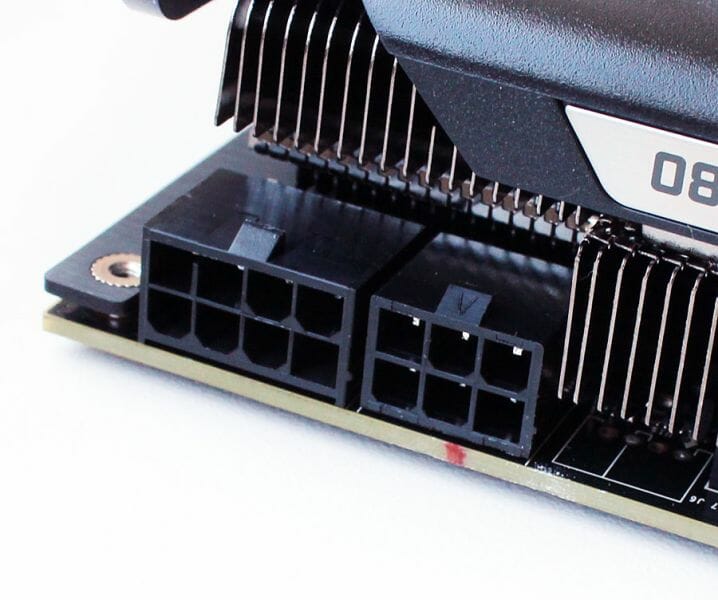
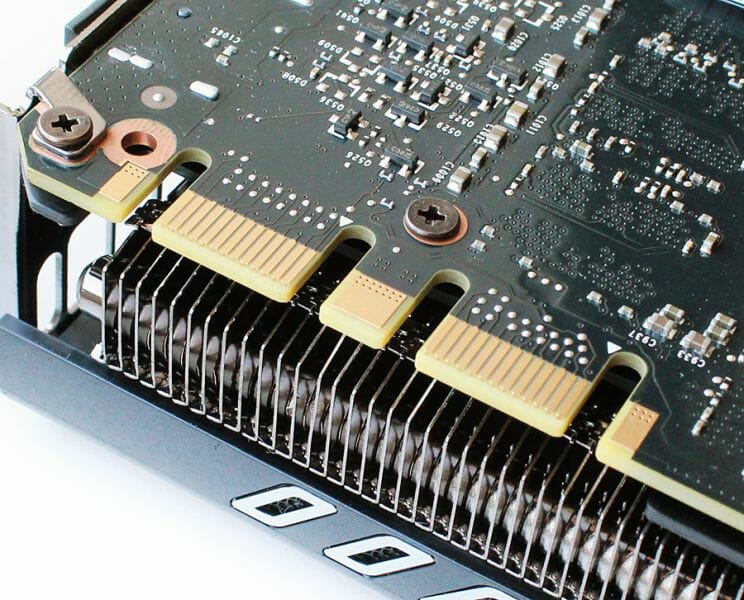
The cooling system is secured with four screws around the GPU, so we could easily take it off:
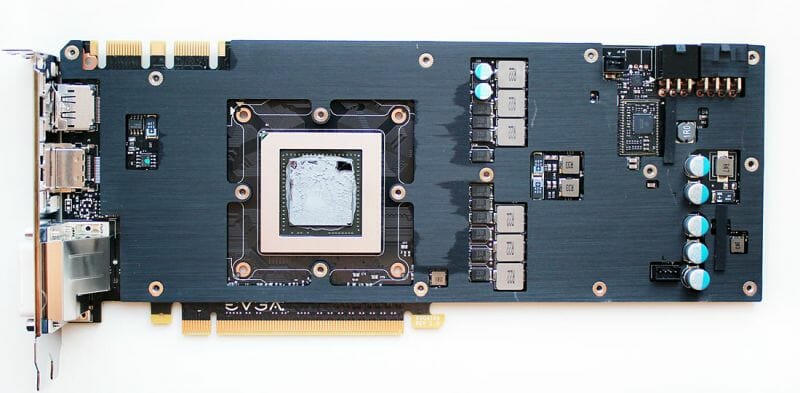
It was somewhat harder to remove the metal plate that covers the graphics memory and power components, especially as it held firmly with its thermal pads even after we had unfastened the screws. With the metal plate out of our way, we could make sure that we were dealing with a copy of the reference GeForce GTX 780.
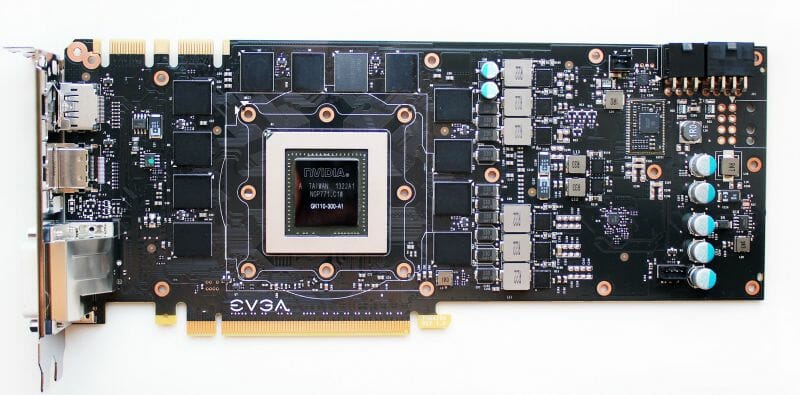
The power system includes 6 phases for the GPU and 3 phases for the graphics card and PLL.
The GPU voltage regulator is based on an ON Semiconductor NCP4206 controller.
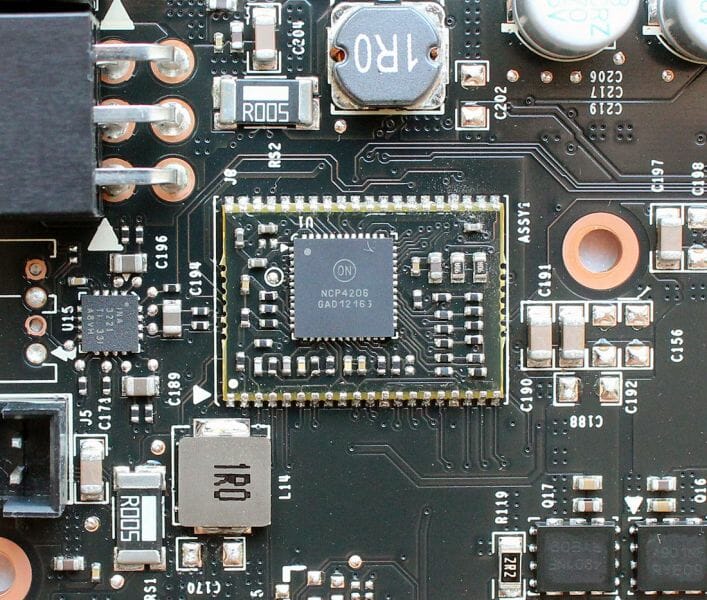
The 28nm GPU chip was manufactured on the 22nd week of 2013 (in late May) in Taiwan. It is revision A1. The GPU die is 561 sq. mm large.
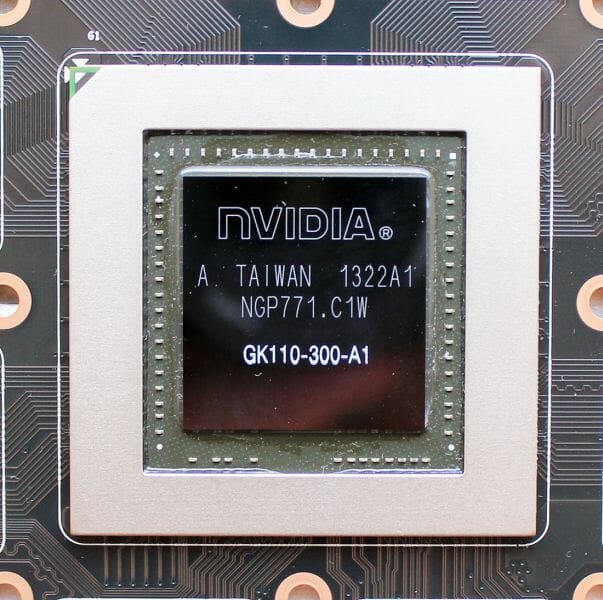
The base GPU frequency of the EVGA GeForce GTX 780 Superclocked ACX is pre-overclocked by 104 MHz (+12.1% above the reference card’s) to 967 MHz. The boost clock rate is supposed to be 1020 MHz but, according to our monitoring data, it reached as high as 1097 MHz with maximum power and temperature targets. That’s some substantial factory overclocking, we must admit. However, it is not the record for the three GeForce GTX 780s we’re discussing today. According to GPU-Z, the ASIC quality of the EVGA’s GPU is 73.0%:
Running a little ahead, we can tell you that it is the best ASIC quality among the six GeForce GTX 780s we’ve tested.
The EVGA card comes with 3 gigabytes of GDDR5 memory in 12 Samsung Semiconductor K4G20325FD-FC03 chips:
They are clocked at their rated frequency of 6008 MHz. Unfortunately, most manufacturers do not try to overclock this memory although its frequency potential is high. Coupled with the 384-bit bus, such overclocking would ensure substantial performance benefits. It might be clocked at 6600 MHz safely enough to make the graphics card faster at high visual quality settings with some type of antialiasing.
Thus, the EVGA GeForce GTX 780 Superclocked ACX has the following specs:
The card features the Active Cooling Xtreme system developed by EVGA. Not very sophisticated in design, it is cleverly and neatly implemented. The cooler consists of a nickel-plated aluminum heatsink with fans, a plastic casing, and a heat-spreading plate:
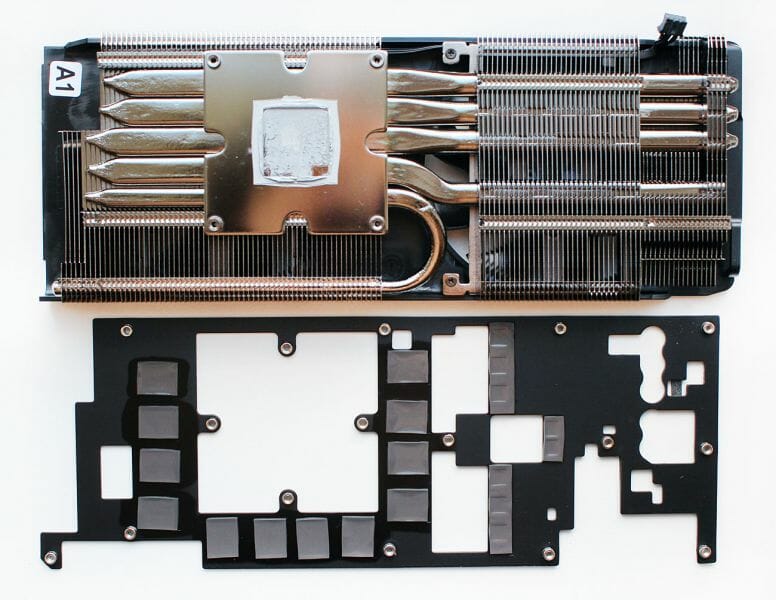
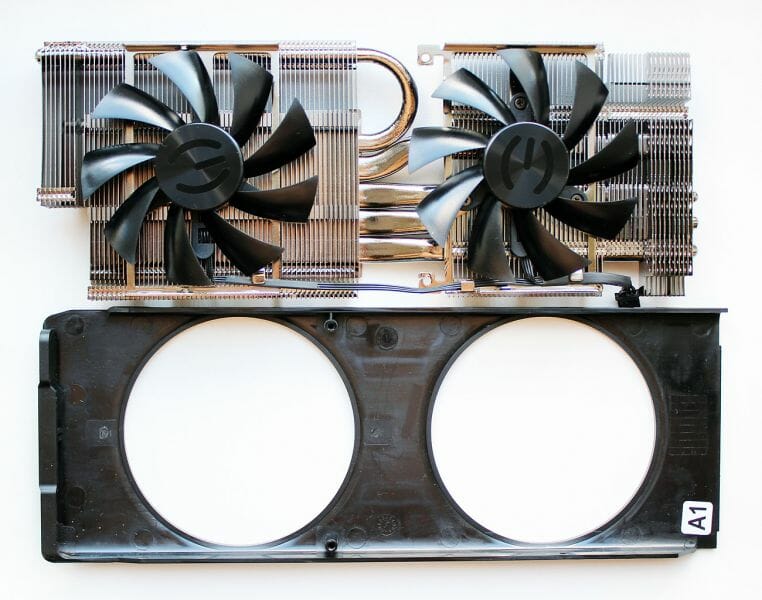
There are four 8mm and one 6mm heat pipe in the heatsink. They are soldered to the copper base:
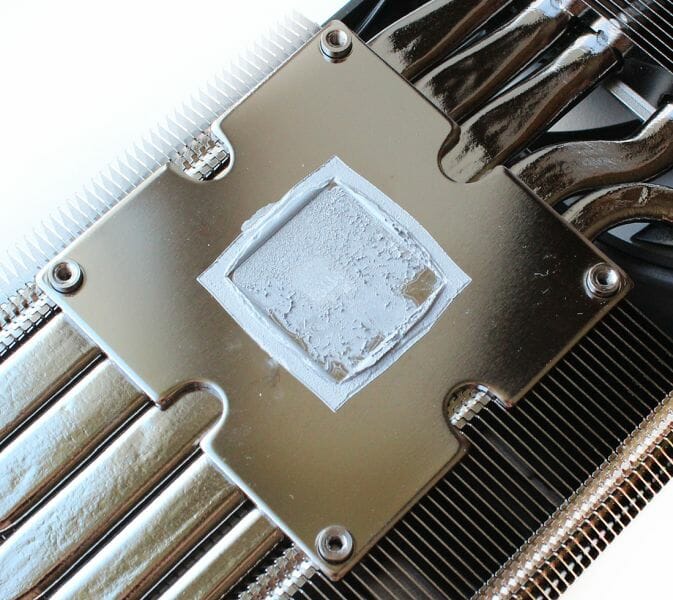
Some of the heatsink fins are perforated in a tessellated pattern:
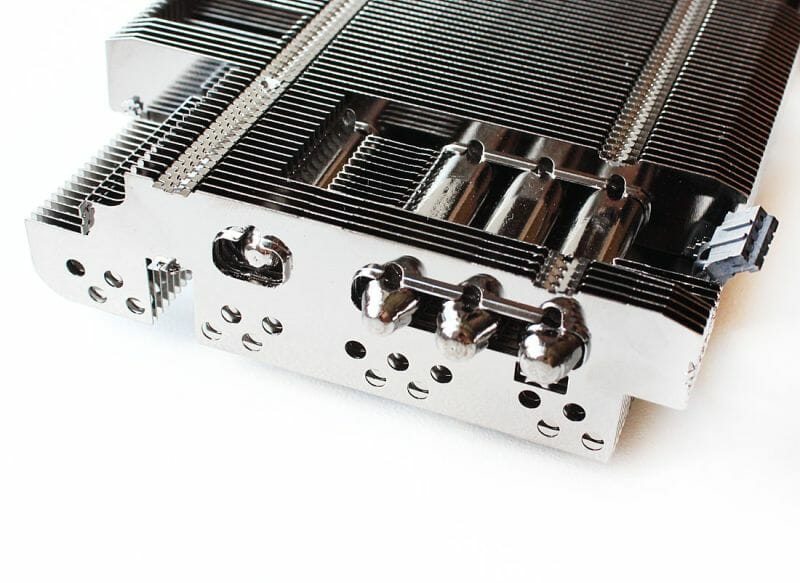
This must have been done to make the air flow more turbulent and thus increase the heat transfer efficiency.
The heatsink is cooled by a pair of identical 92mm fans from Power Logic.
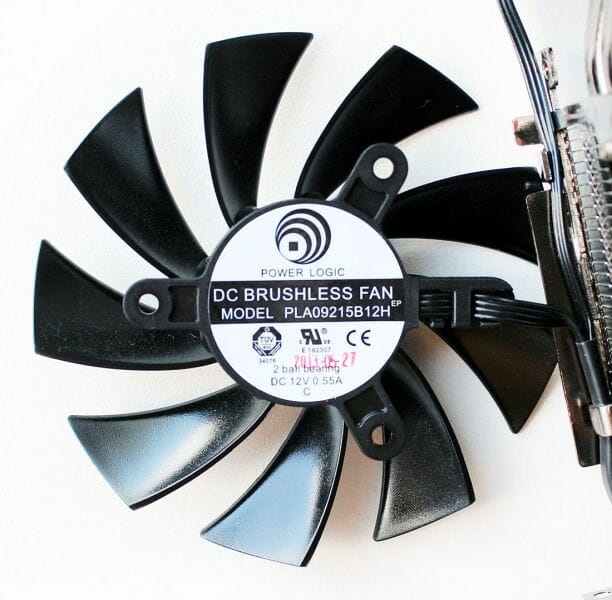
The PLA09215B12H fans run on dual ball bearings, so the manufacturer guarantees them to last for at least 12 years. Thanks to PWM-based regulation, the speed of the fans can vary in a range of 1000 to 3300 RPM. So, EVGA’s cooler looks promising but let’s check it out in practice before jumping to conclusions.
Here in after, to check out the cards temperatures we used five runs of the pretty resource-hungry Aliens vs. Predator (2010) benchmark at the highest visual quality settings, at a resolution of 2560×1440 pixels. We used 16x anisotropic filtering but no MSAA 4x:
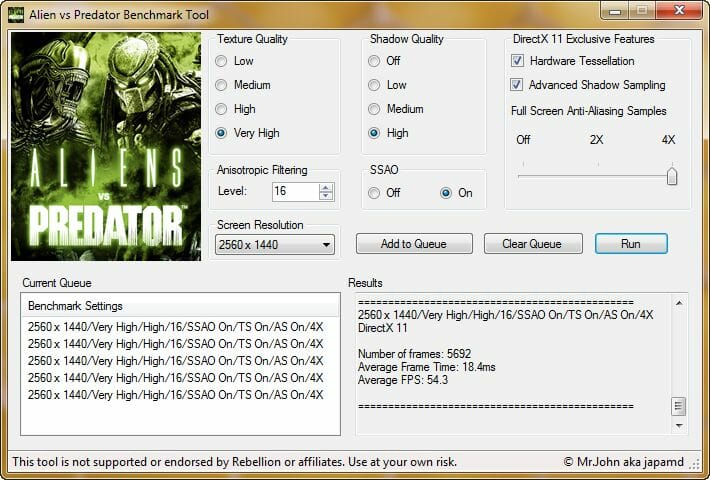
We used MSI Afterburner 3.0.0 beta 14 and GPU-Z version 0.7.2 for monitoring of temperatures inside the closed system case, which configuration is discussed in detail in the corresponding chapter of the roundup. All tests were performed at 26°C room temperature.
Here is how efficient EVGA’s ACX cooler is with its fans regulated automatically and at their maximum speed:
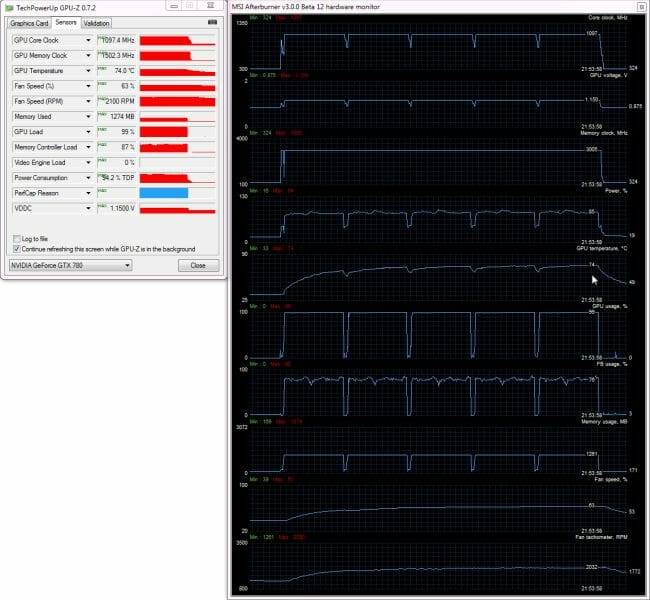
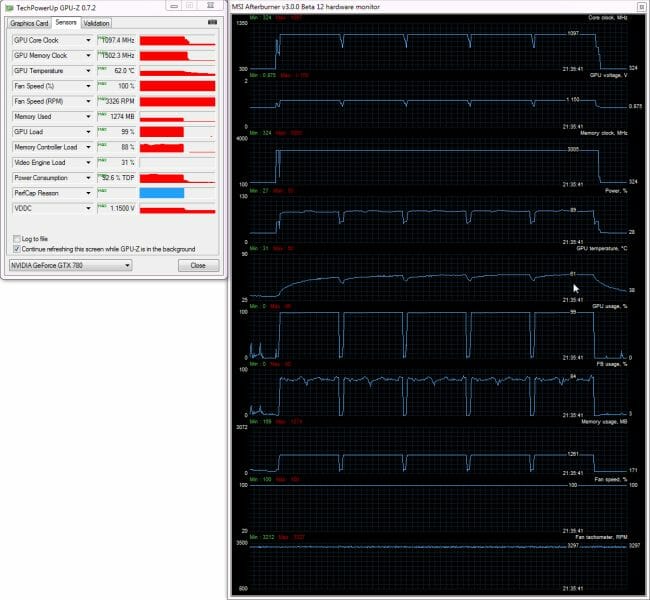
The noise factor apart, the cooler seems to cope with its job well enough. In the automatic fan regulation mode, the speed of the fans would peak up to 2100 RPM and the GPU was 74°C hot. At the maximum speed of 3330 RPM, the cooler kept the temperature at 62°C. So, despite the increased GPU clock rates, the ACX cooler is definitely more efficient than the reference cooler from Nvidia and, for example, than the Twin Frozr IV from MSI.
In our overclockability test, we increased the GPU and memory frequencies of the EVGA GeForce GTX 780 Superclocked ACX by 70 and 1320 MHz, respectively.
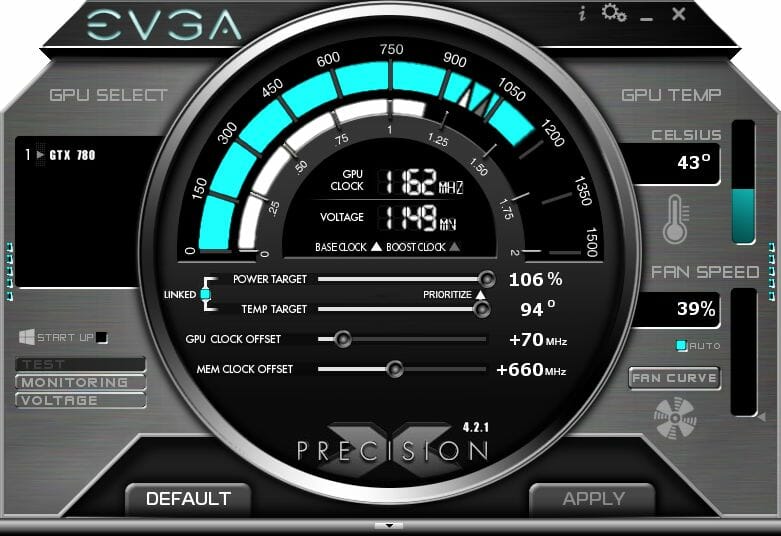
The resulting clock rates were 1037/1090/7328 MHz, which is very good for a top-end graphics card.
The peak GPU frequency of the overclocked card was 1163 MHz. The GPU was 78°C hot with the fans rotating at 2190 RPM.
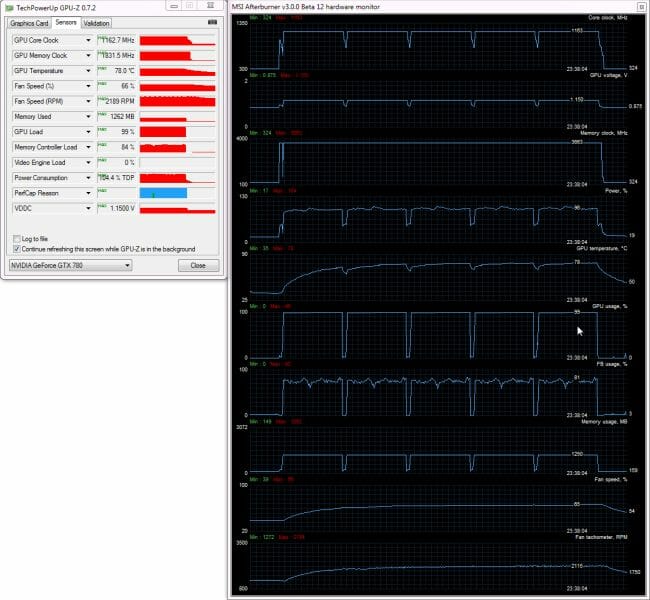
We guess that’s a good result, but let’s first see what the other two products have to show us.
Gigabyte GeForce GTX 780 OC WindForce X3 3GB (GV-N780OC-3GD)
Gigabyte Technology has five GeForce GTX 780 modifications in its model range but two of them are just new revisions of older products. We’ve got a first-revision GV-N780OC-3GD model, which is the fastest that Gigabyte offers.
Unfortunately, we received the card without packaging and accessories, so its pack shot is taken from the official website:
The GeForce GTX 780 OC WindForce X3 is manufactured in China and comes with a 3-year warranty. It sells at $679 in retail.
The card is equipped with a triple-fan cooler that covers its entire face side. With translucent fans and perforated casing, the card doesn’t look bulky.
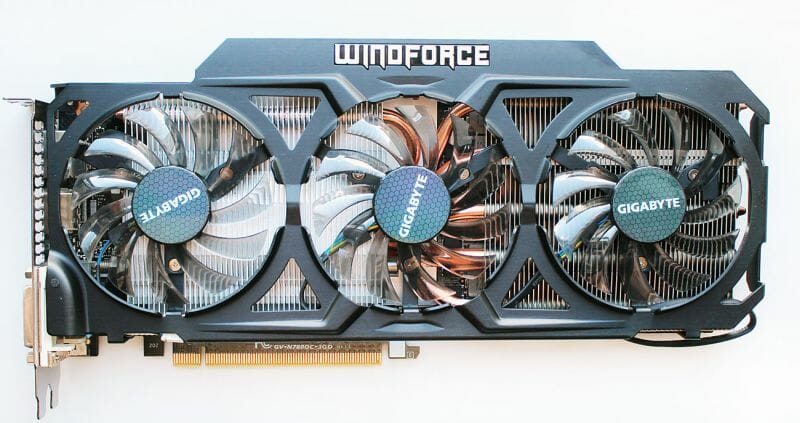
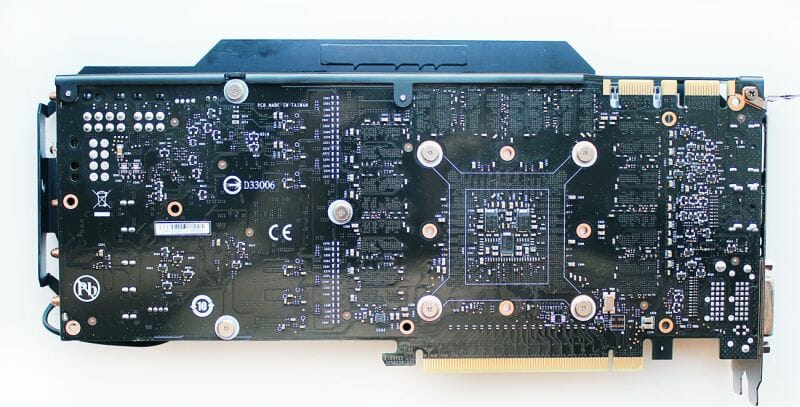
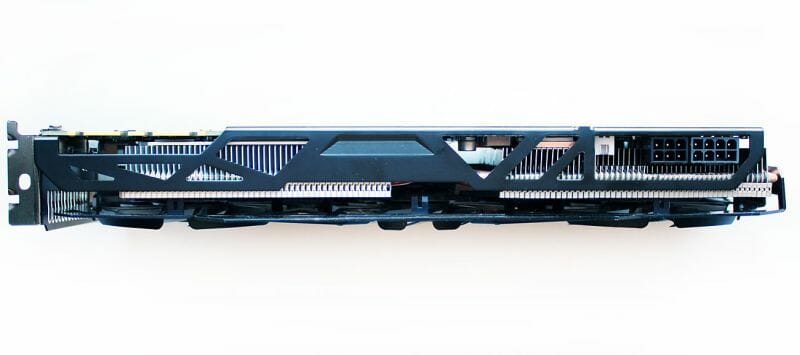
It measures 292x129x43 mm and has a standard selection of video outputs:
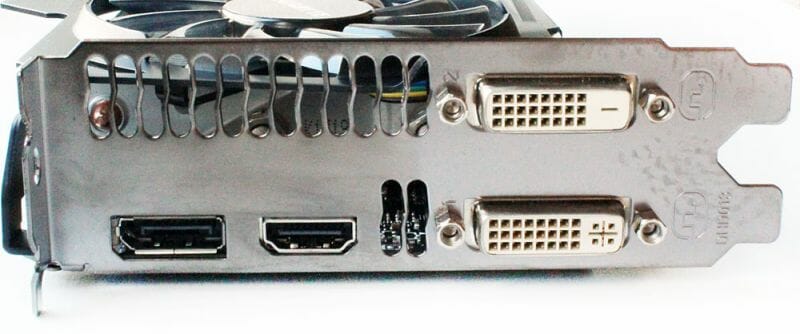
The power and MIO connectors are standard as well:
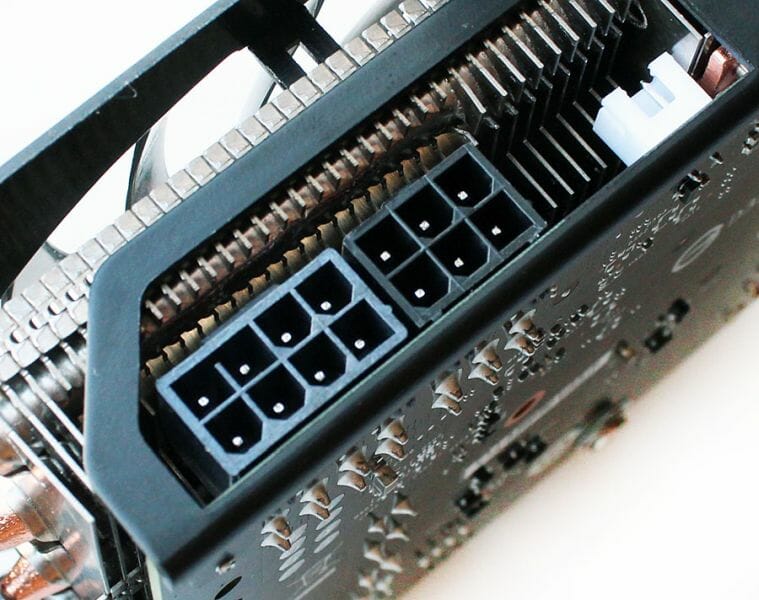
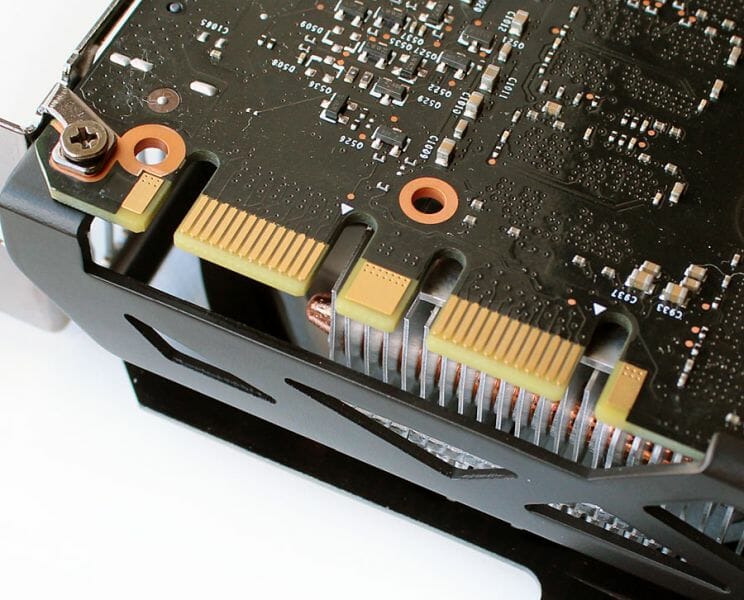
As opposed to the EVGA, the Gigabyte had no separate cooling plate on the memory chips and power transistors which are cooled by the main heatsink. It was easy to take it off, so we could see a reference PCB once again:
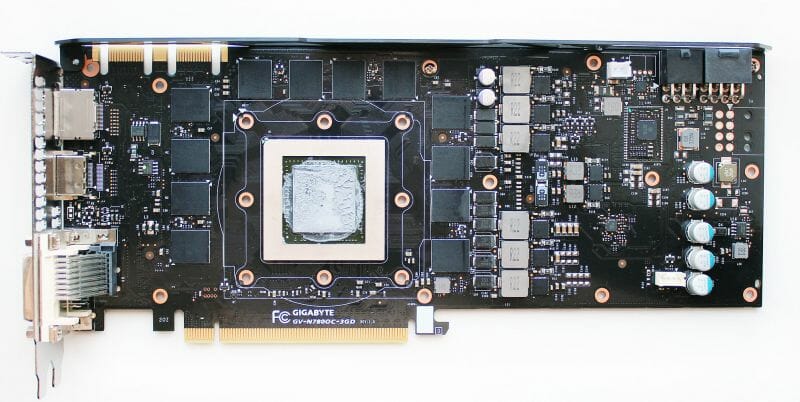
The power system and controller are standard:
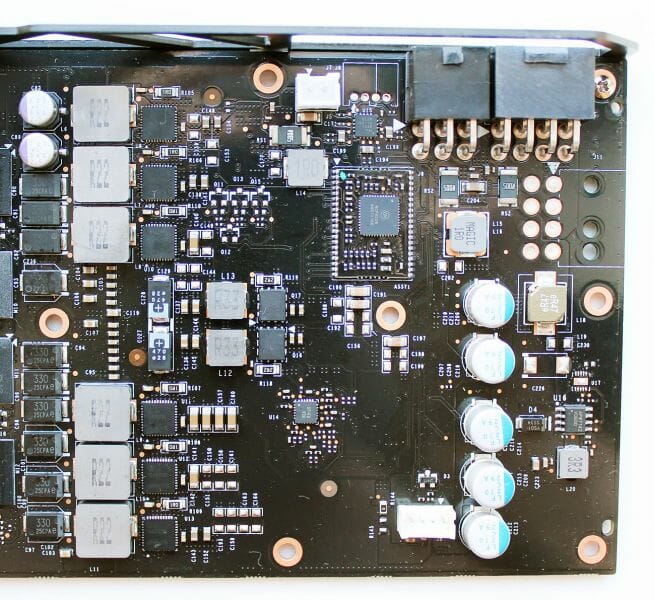
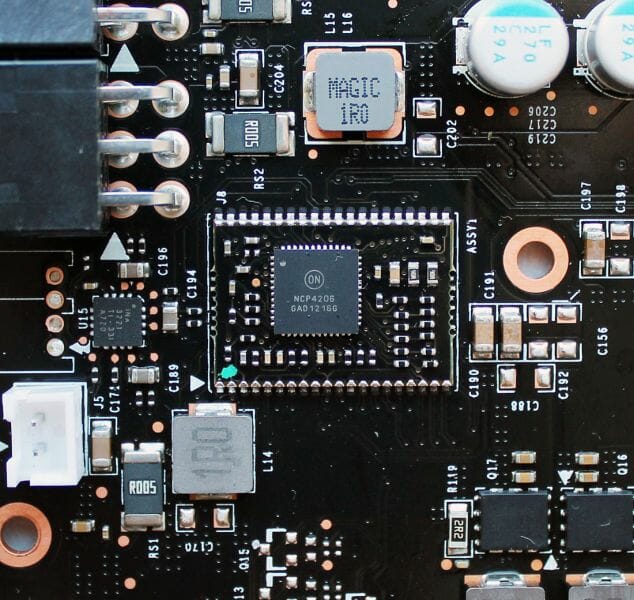
The GPU is revision A1. It was manufactured in late March, 10 weeks earlier than the EVGA’s chip.
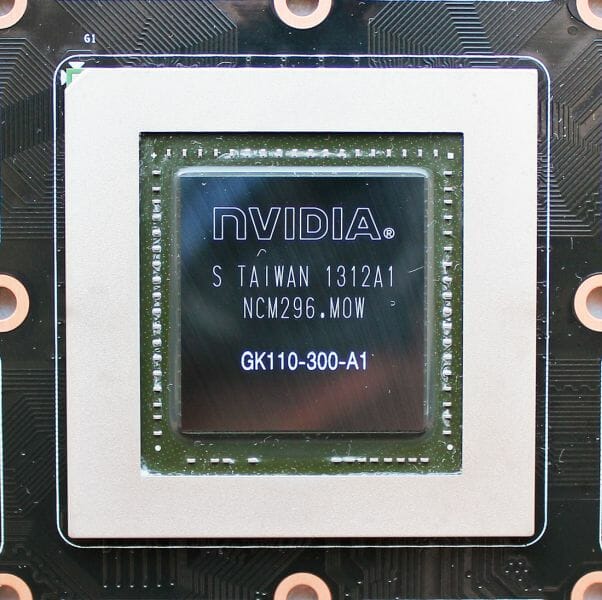
It is clocked at 954/1006 MHz in 3D applications, which is 10.5% higher than the reference card’s clock rates. According to our monitoring data, its frequency peaked up to 1058 MHz at high loads. The ASIC quality of the GPU is 62.1%:
We can see the same GDDR5 memory chips (Samsung K4G20325FD-FC03) as on the EVGA card. The total memory amount is 3 GB.
The memory frequency is standard, so the Gigabyte only differs from the reference GTX 780 in its GPU specs:
The graphics card features Gigabyte’s WindForce X3 cooler which is claimed to be able to dissipate up to 450 watts. That’s more than enough to cope with the 250-watt GeForce GTX 780. And such an ambitious cooler is only two PCIe slots large:
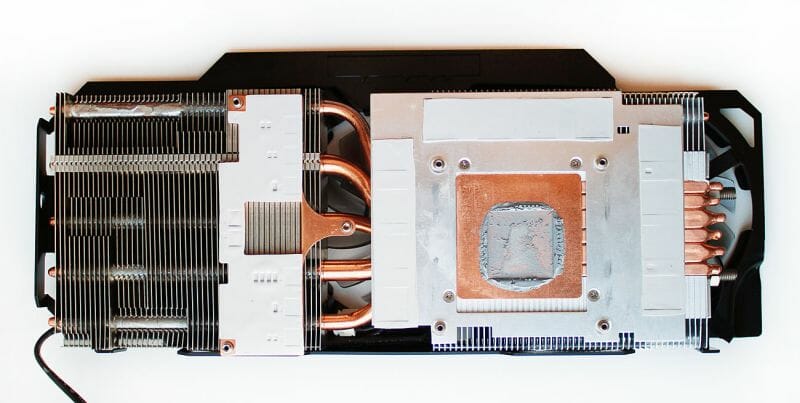
Its heatsink consists of two parts connected with six heat pipes. Four of these pipes are 6 mm in diameter and two, 8 mm. Besides the copper base the heat pipes go out from, an aluminum plate is secured on the main heatsink and contacts with the memory chips via thermal pads. The power components are cooled by a copper plate attached to the auxiliary heatsink.
The heat pipes are soldered to the cooler’s base and to the heatsink fins.
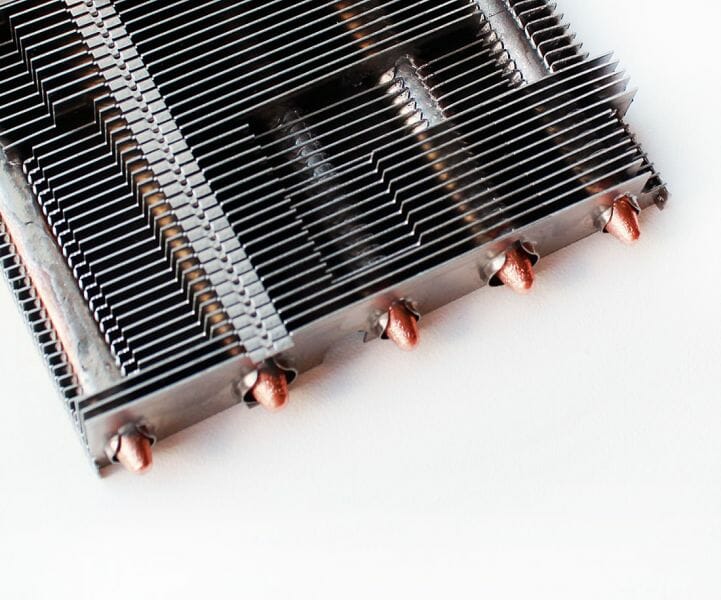
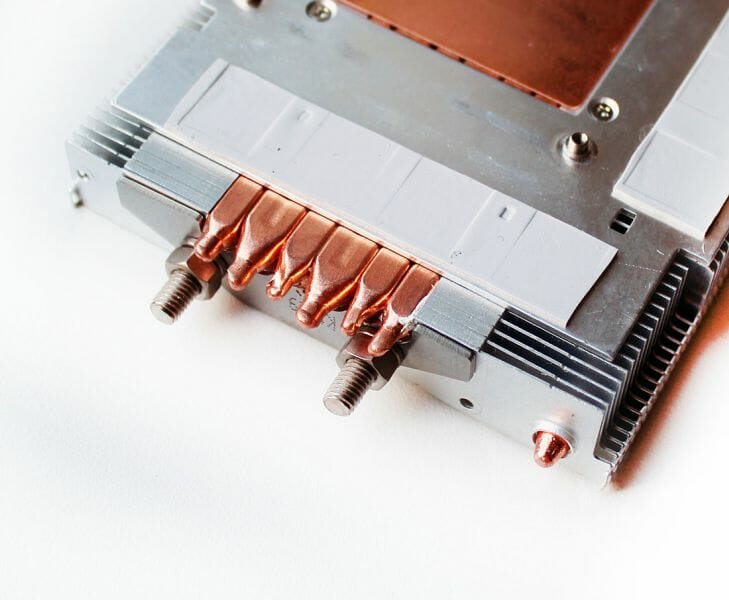
The heatsink is cooled by three 80mm Everflow T128010SU fans (the actual diameter of the impeller is 74 mm).
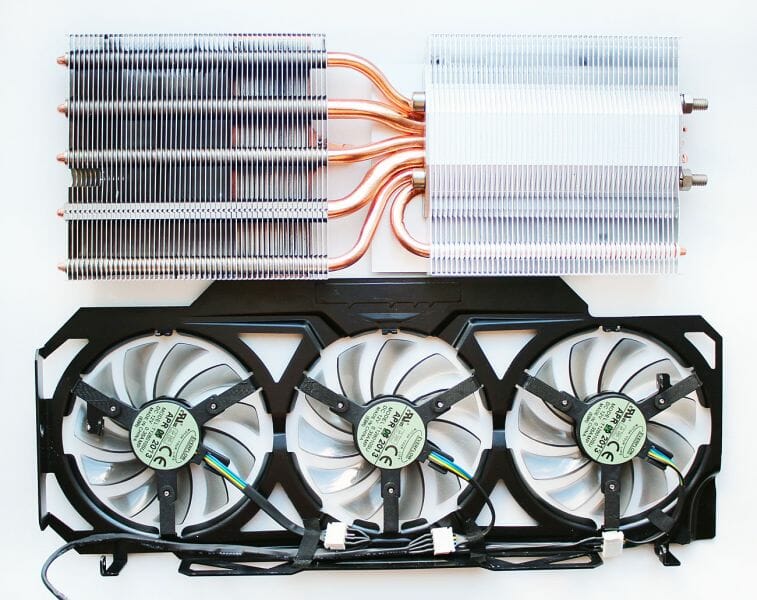
Their improved sleeve bearing is supposed to last for at least 50,000 hours. Their speed is PWM-regulated in a range of 800 to 4700 RPM.
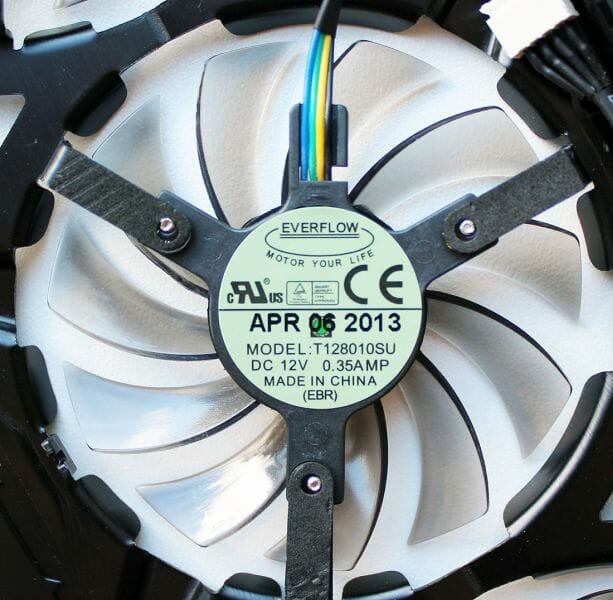
Tested under the same conditions as the EVGA, the Gigabyte GeForce GTX 780 OC WindForce X3 had the same GPU temperature in the automatic fan regulation mode (74°C). At the maximum speed of 4730 RPM, its GPU was only 61°C hot.
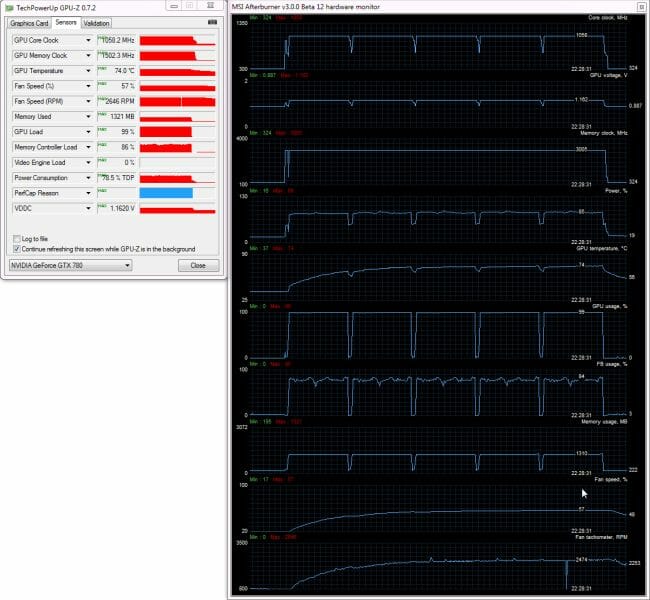
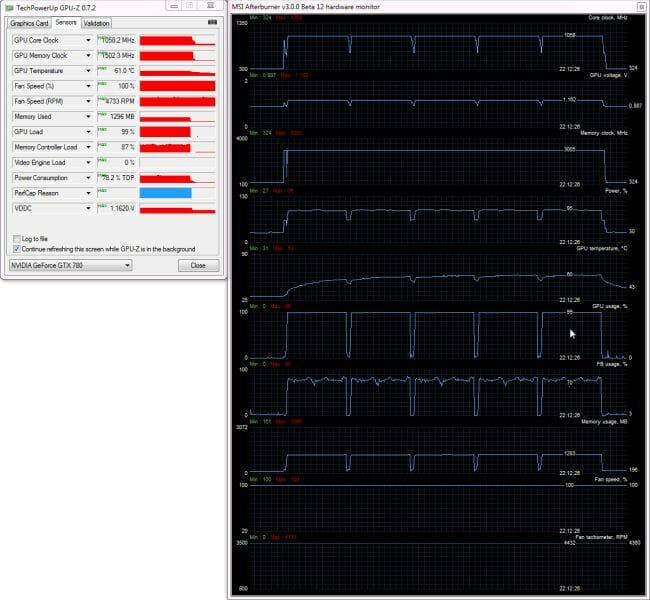
In our overclockability tests the Gigabyte GeForce GTX 780 OC WindForce X3 was stable at a 70MHz higher GPU clock rate whereas its memory could be overclocked by 1060 MHz.
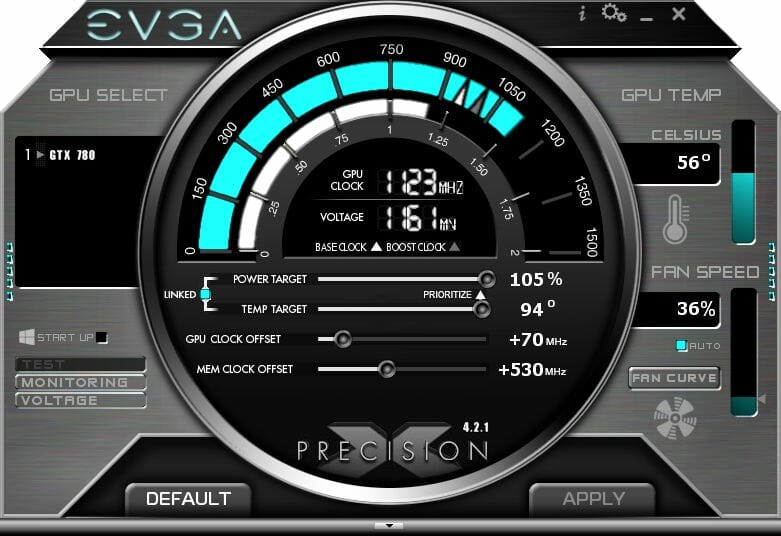
Since the default clock rate of the Gigabyte card is somewhat lower than that of the above-discussed EVGA, the resulting frequency is lower, although the overclocking gain is the same.
When overclocked, the Gigabyte’s GPU grew as hot as 75°C, the cooler’s fans rotating at 2920 RPM.
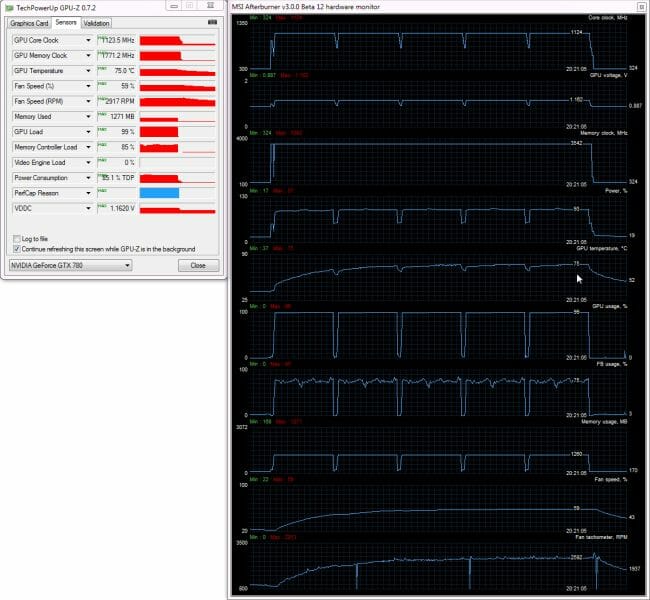
Inno3D iChill GeForce GTX 780 HerculeZ X3 Ultra 3GB
Inno3D produces four GeForce GTX 780s, and only one of them follows the reference design. We’ll test the fastest of the remaining three, which is called Inno3D iChill GeForce GTX 780 HerculeZ X3 Ultra.
The colorful wrapper of the product box was lost, so we again show you a pack shot from the official website:
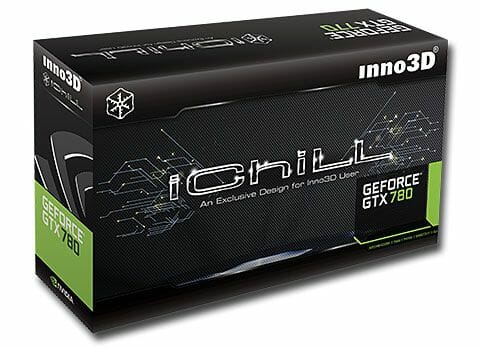
The accessories to this card include one power adapter, a DVI->D-Sub adapter, a software CD, a coupon to download 3DMark Advanced Edition, a PSU product booklet, an installation guide, and a high-quality mouse pad:
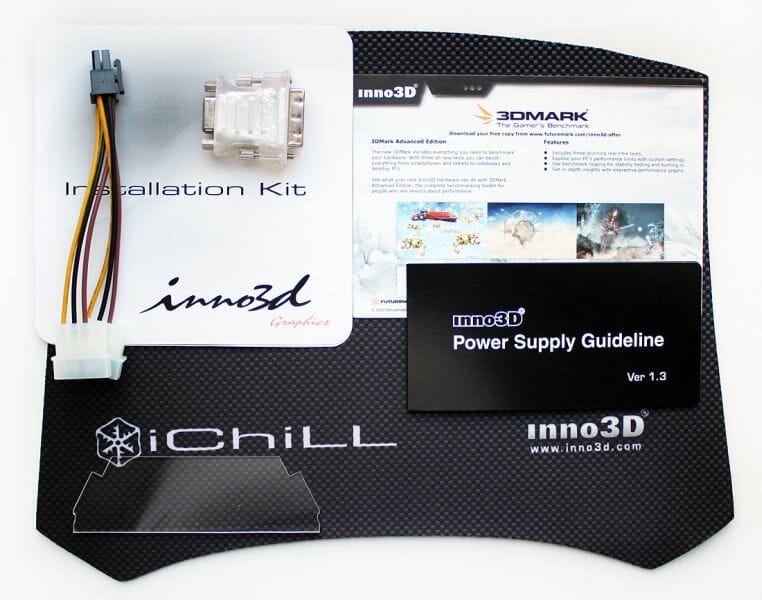
The card is manufactured in China and costs $679. The warranty is 3 years long as far as we know.
The Inno3D iChill GeForce GTX 780 HerculeZ X3 Ultra is the largest GeForce GTX 780 we’ve ever tested with dimensions of 302x112x58 mm. While its length and height are quite normal for a top-end product, the thickness of 58 mm means that the card is going to block the two nearest PCIe slots on the mainboard.
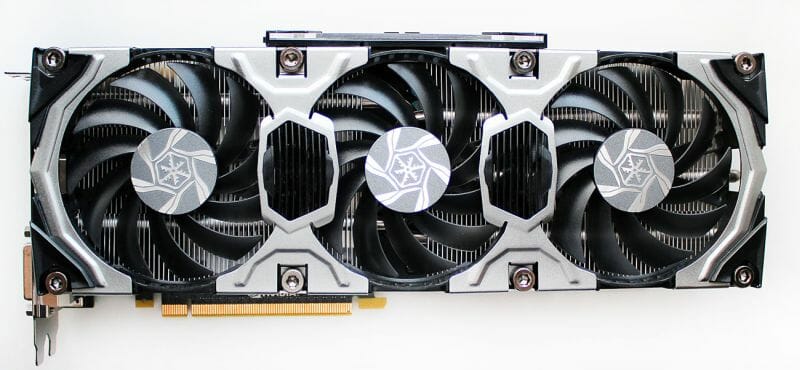
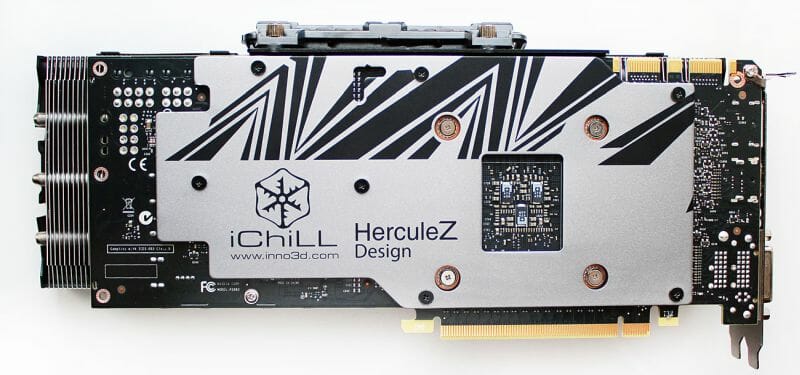
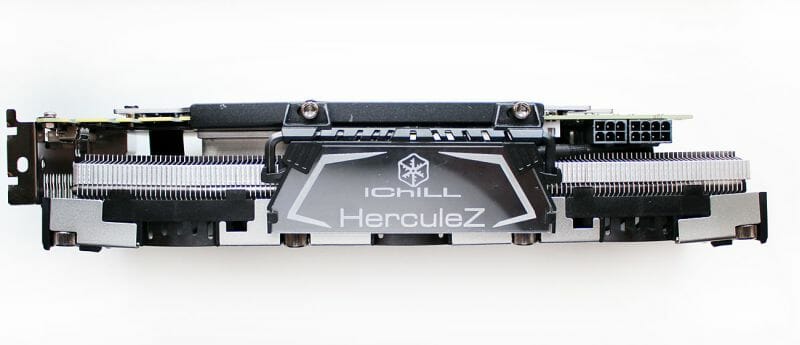
The Inno3D card looks powerful with its three 90mm fans set into titanium-like metal inserts. Its reverse side is almost all covered by a similarly styled back-plate. The series logos are painted on a faceplate made of translucent plastic. This graphics card looks like a tremendous war machine that’s capable of crunching through any 3D game.
It has the same video, power and SLI connectors as the reference GeForce GTX 780.
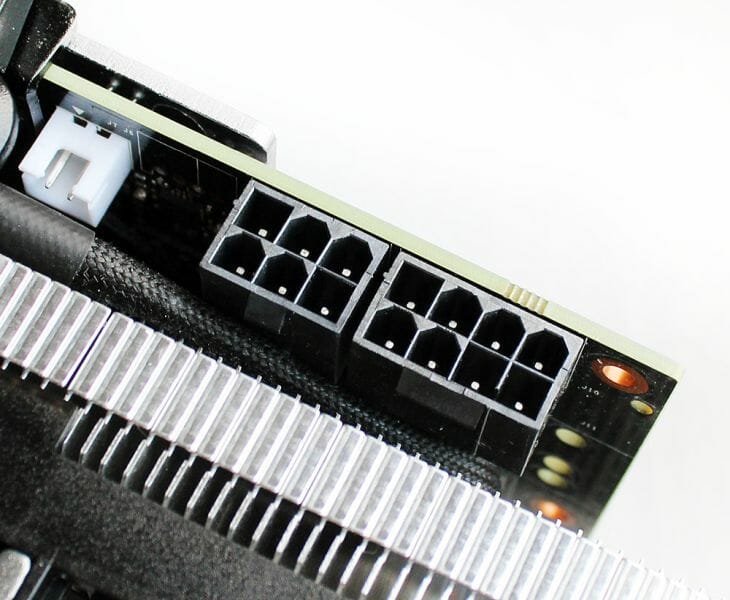
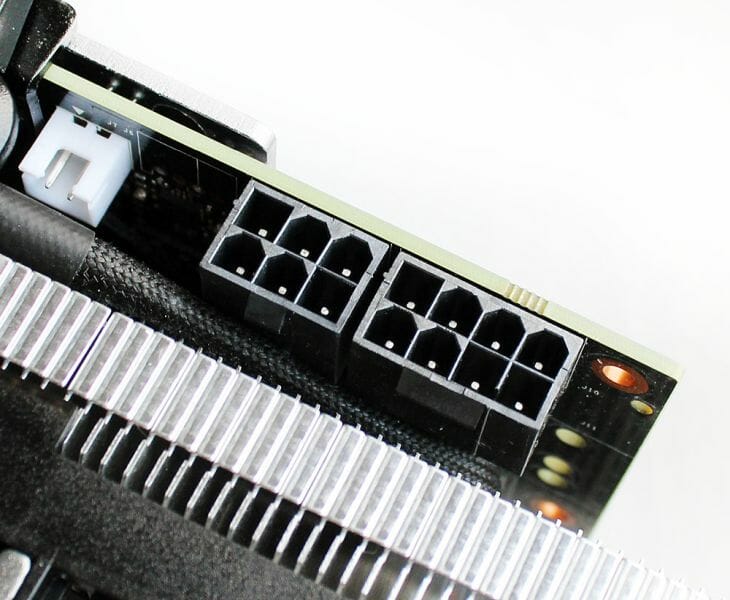
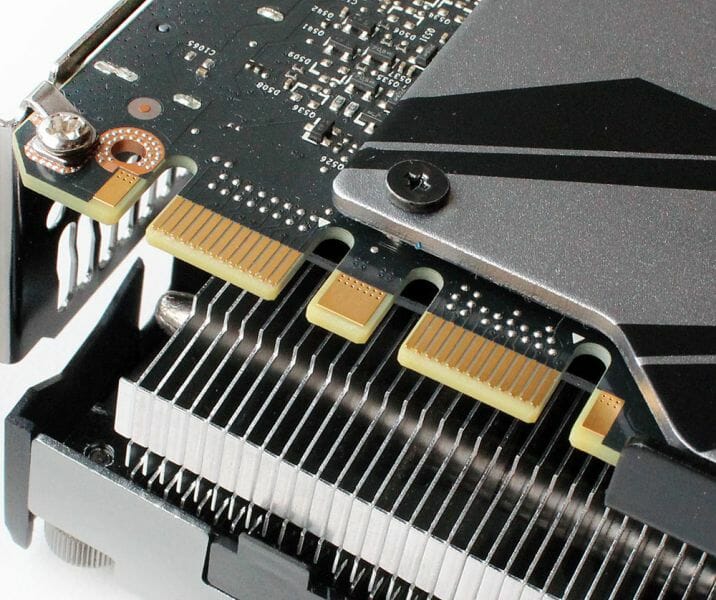
However, the Inno3D iChill GeForce GTX 780 HerculeZ X3 Ultra is specified to have a peak power draw of 265 rather than 250 watts. A 600-watt PSU is recommended for a computer with one such device inside.
Having removed the cooler and the heat-spreading plate that’s fastened to the backplate, we saw a reference PCB once more.
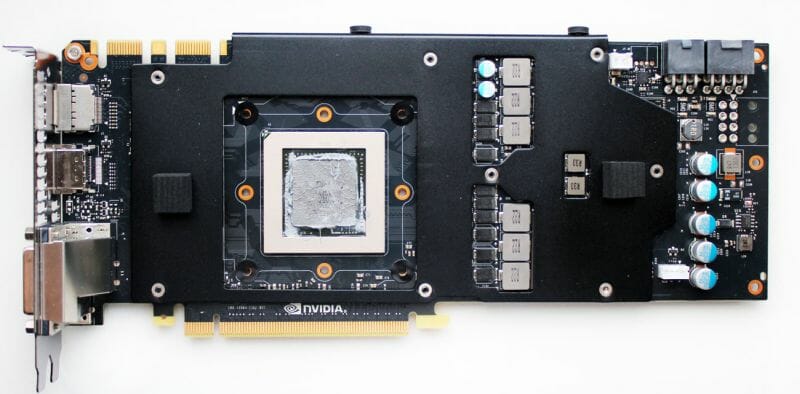
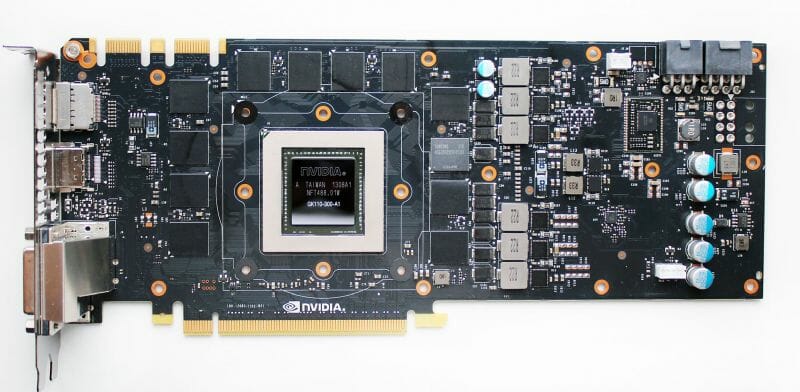
It is exactly like the reference GeForce GTX 780. We could find not even a minor difference.
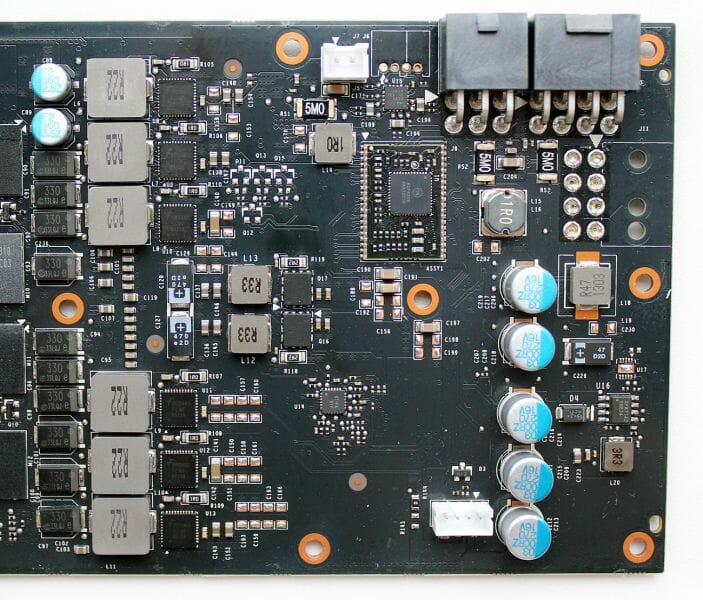
The GPU die is only different from the previous two in its manufacture date (late February, 2013).
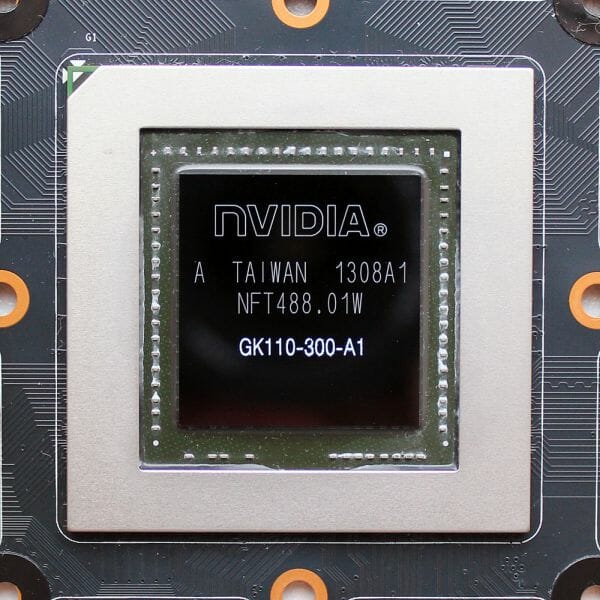
The Inno3D has the highest default GPU frequency among all GeForce GTX 780s we’ve tested: 1006/1046 MHz (+16.6%). According to our monitoring tools, the frequency peaked up to 1111 MHz. That’s some nice factory overclocking, but can the card be overclocked even more?
Interestingly, the high frequencies are guaranteed despite the low ASIC quality of the chip, which is only 62.0%:
Of course, we’re talking about a particular sample of the graphics card, yet this fact serves to prove that there is no direct relation between a chip’s ASIC quality and frequency potential.z
The memory chips are the same as we’ve seen on the two previous graphics cards in this review.
The memory is pre-overclocked, though. Instead of the rated 6008 MHz, it is clocked at 6212 MHz.
Inno3D is especially proud of its original HerculeZ X3 Ultra cooler:
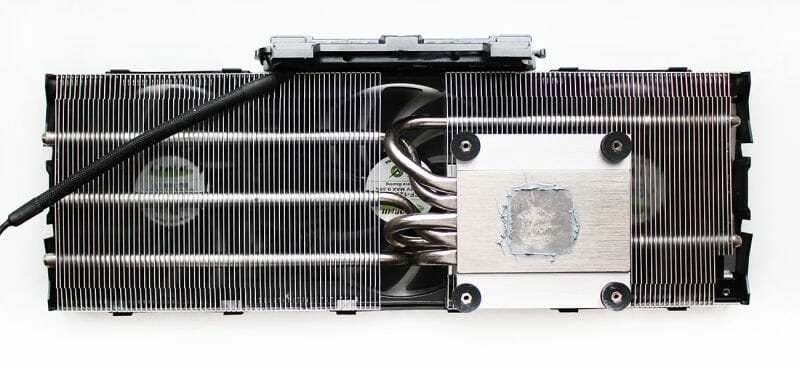
By making the cooler large, they managed to increase its efficiency far above that of the other original coolers for GeForce GTX 780s, some of which are developed by more renowned brands than Inno3D. Let’s take a closer look at this thing:
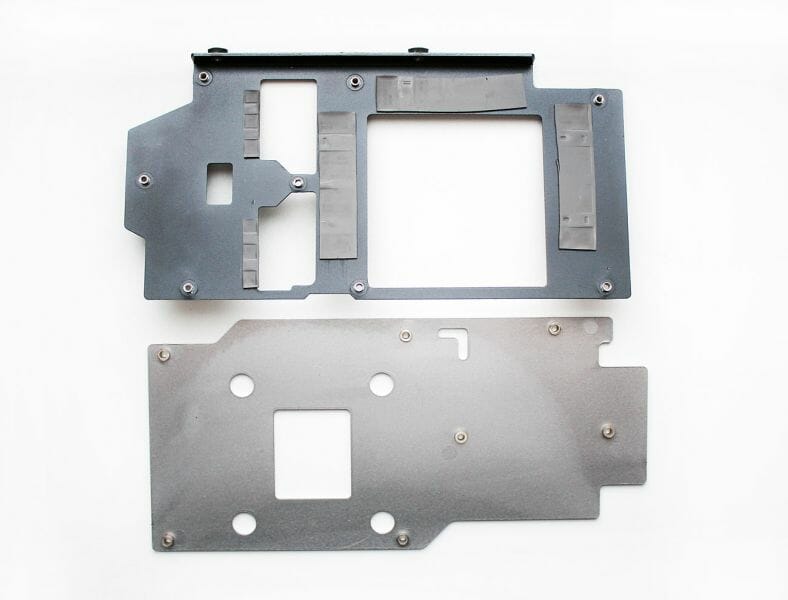
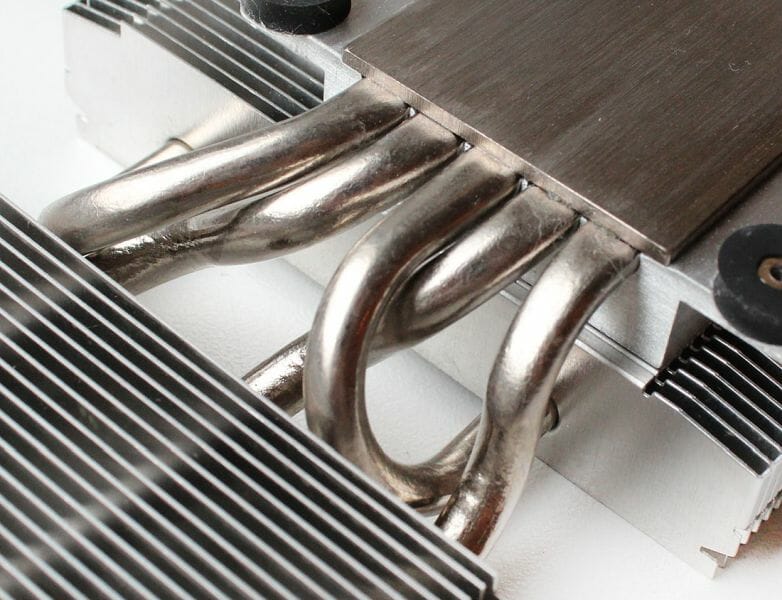
The HerculeZ X3 Ultra has an aluminum heatsink with five nickel-plated copper heat pipes, 6 mm in diameter. All of the pipes appear from one side of the nickel-plated copper base and then, bending and alternating with each other, go to the two separate heatsinks.
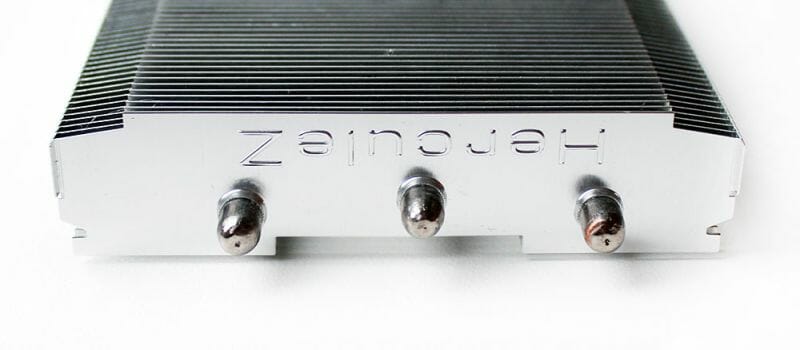
Three heat pipes pierce the large heatsink consisting of a number of aluminum fins embellished with a pressed-out name of the cooler series. The other pipes go through the smaller heatsink in the same way.
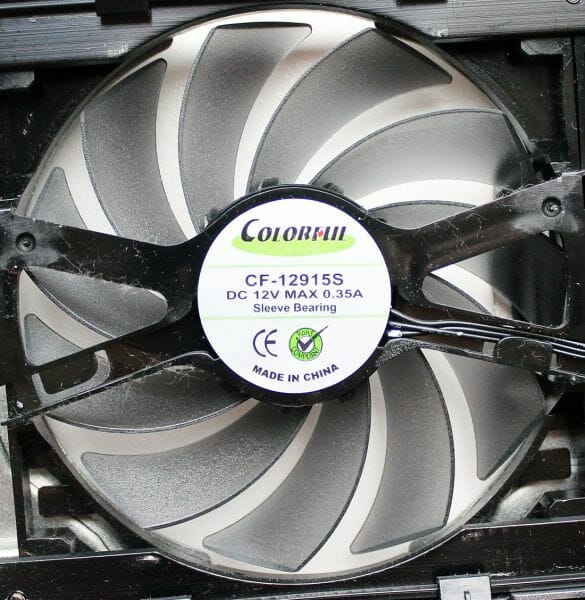
The fins seem to be press-fitted onto the pipes, yet the heatsink is all neat and robust. None of the fins is loose.
The cooler is equipped with three 90mm Colorful CF-12915S fans.
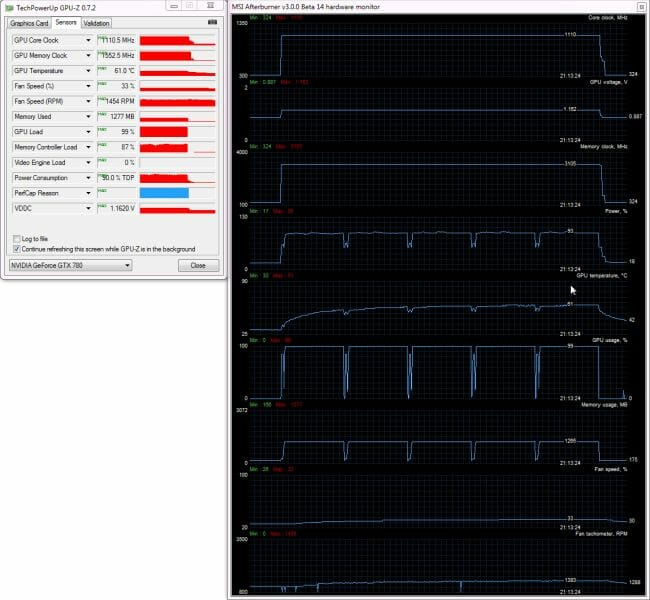
The fans run on sleeve bearings and should be quiet at work. They are dust-resistant and let you take off their impellers for cleaning. The speed of the fans is PWM-regulated in a range of 1000 to 3300 RPM. Besides, there is a small switch in the top part of the cooler, right below the highlighted logo, which can be used to turn off the PWM regulation and enable the Boost mode (i.e. make the fans work at their maximum speed).
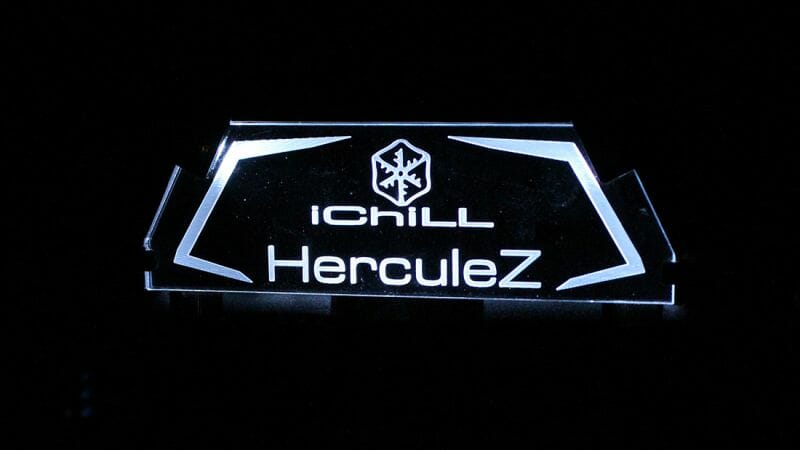
By the way, there’s a plastic faceplate among the card’s accessories, using which you can make your own logo and put it on your graphics card.
Now, here’s how efficient the HerculeZ X3 Ultra is:
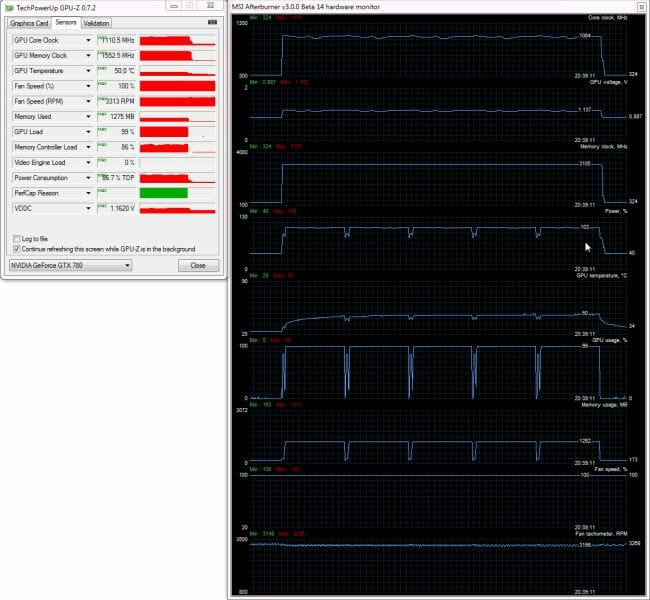
The GPU is 61°C hot in the automatic fan regulation mode, with the fans rotating at up to 1450 RPM, and only 50°C hot at the maximum speed of the fans. We should remind you that we’re talking about a top-end graphics card with a pre-overclocked 561 sq. mm GPU! The rest of the GeForce GTX 780 coolers we’ve tested so far are clearly inferior to it in performance. We guess such high efficiency is worth the third blocked PCIe slot.
We didn’t expected the Inno3D iChill GeForce GTX 780 HerculeZ X3 Ultra to have any overclocking potential left, yet we still managed to increase the GPU and memory clock rates by 50 and 960 MHz, respectively.
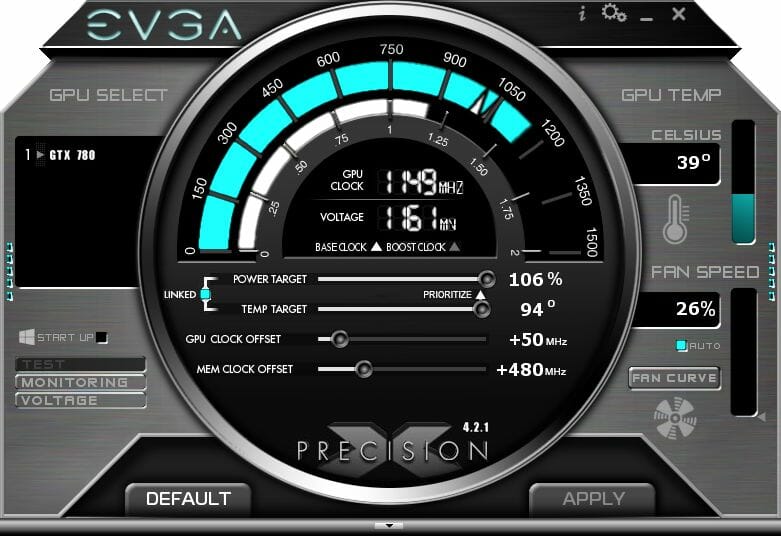
The overclocked card worked at 1056/1096/1793 MHz.
Although the GPU frequency would go up to 1150 MHz during our tests, the HerculeZ X3 Ultra didn’t find it to be a problem:
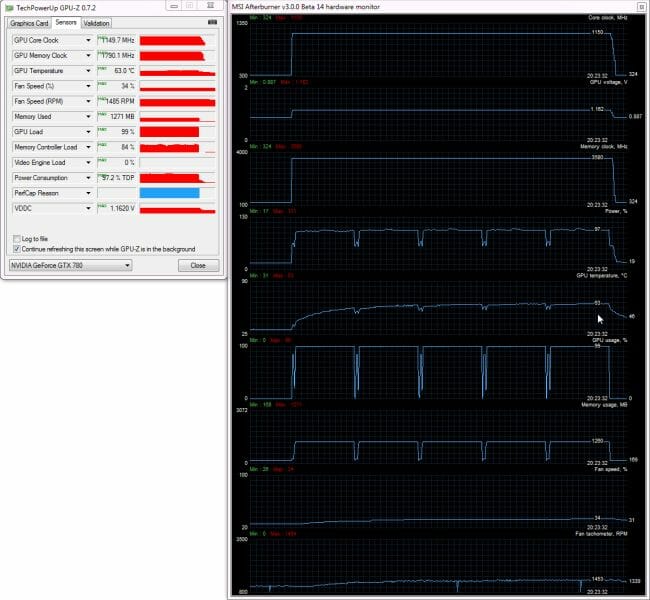
The GPU is only 63°C hot, with the fans rotating at 1490 RPM. That’s impressive indeed.
Noise Level and Power Consumption
The noise level of each cooler was measured between 1:00 and 3:00 AM in a closed room about 20 m2 big using CENTER-321 electronic noise meter. The noise level for each cooler was tested outside the system case when the only noise sources in the lab were the cooler and its fan. The noise meter was installed on a tripod and was always at a 150 mm distance from the cooler fan rotor. The tested cooling systems were placed at the edge of the desk on a sheet of polyurethane foam. The lowest noise reading our noise meter device can register is 29.8 dBA and the subjectively comfortable noise level in these testing conditions was around 36 dBA (do not mix it up with low noise level). The fan(s) rotation speed was adjusted in the entire supported range using our precise in-house controller by changing the voltage with 0.5 V increment.
Besides the three graphics cards from this review, we include the results of a reference Nvidia GeForce GTX 780 as well as of the MSI OC Gaming which turned out to be the quietest GTX 780 in our earlier tests. The vertical dotted lines mark the peak speed of the coolers’ fans in the automatic regulation mode. Now, let’s see what we have in the diagram and table:
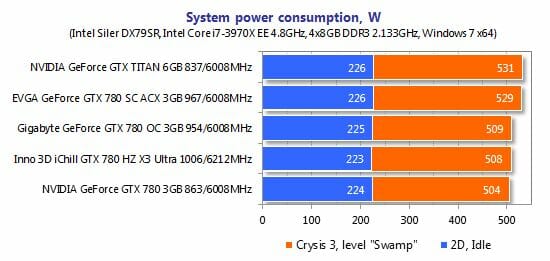
Judging by the noise level graphs, the Gigabyte is the quietest card whereas the MSI and Inno3D are the loudest. However, things are not that simple when it comes to practice. When the coolers’ fans are regulated automatically, it is the cards from MSI and Inno3D that have the lowest noise level at high loads while the Gigabyte is hardly any quieter than the reference GTX 780 from Nvidia.
As for our subjective impressions, the Gigabyte’s cooler should be given credit for the rather soft and comfortable sound of its fans. The Inno3D’s fans rattled annoyingly at low speeds. As for the EVGA card, it is, unfortunately, rather loud according to our measurements.
We measured the power consumption of our testbed equipped with different graphics cards using a multifunctional Zalman ZM-MFC3 panel which can report how much power a computer (without the monitor) draws from a wall outlet. There were two test modes: 2D (editing documents in Microsoft Word or web surfing) and 3D. In the latter case the load was created by four runs of the introductory “Swamp” scene in Crysis 3 game at 2560×1440 with maximum image quality settings, but without MSAA.
As expected, the different GeForce GTX 780s have comparable power consumption:

Interestingly, the configuration with the Inno3D, which has the highest clock rates, does not have the highest power requirements. On the contrary, it needs but hardly more than the configuration with the reference Nvidia GeForce GTX 780. Having lower clock rates, the EVGA consumes 20 watts more in the same configuration and under the same load, which is similar to the power draw of the configuration with one GeForce GTX Titan. Anyway, the different versions of the GeForce GTX 780 are comparable in terms of their power consumption, so any of the tested configurations can be powered by a 550- or 600-watt PSU.
Noise & Temperature Summary on Six GeForce GTX 780s
Counting this review in, we’ve tested as many as six GeForce GTX 780 variants. Since we test their temperature and noise level under the same conditions, we can compare them in the following charts and table.
The diagram below shows the noise level in the automatic fan regulation mode and at the maximum speed of the fans together with max GPU temperature data (the graphics cards are sorted in the order of ascending GPU temperatures in each diagram):
When it comes to temperature, we have five GeForce GTX 780s and one Inno3D which plays in a league of its own. The Inno3D’s cooler is far superior to any other in every fan regulation mode. The other five coolers are comparable to each other in performance. The MSI and the Inno3D are better than the others in terms of noise in the automatic fan regulation mode.
The following table shows the default and overclocked frequencies of the tested cards. The best results are marked in red. The worst results are blue.
The Inno3D has the highest default clock rates whereas the Gigabyte, the lowest. However, as our benchmarks will show you, this difference only means a gap of 1 or 2% in performance. The highest base frequency in overclocked mode was reached by the Inno3D, too. However, the MSI and EVGA had the highest peak GPU frequency according to our monitoring tools. The Palit notched the highest memory frequency.
The next diagram shows the GPU temperature and noise level of the overclocked GeForce GTX 780s in the automatic fan regulation mode (the cards are again sorted in the order of ascending GPU temperature):
The Inno3D is in the lead again, but now in terms of noise level. It is just a perfect card for overclocking and comfortable gaming. Next goes the reference Nvidia at 75% fan speed, which is followed by the Gigabyte. The cards from Palit, MSI and EVGA take last places with similar results. The MSI is the quietest in this trio, so the choice is obvious, considering the same temperature.
Performance Analysis
We’ve tested GeForce GTX 780 cards a number of times, so we’ll only run some of the most resource-consuming benchmarks and games today. We’ll check out all the three products at their default clock rates and compare them with the reference Nvidia GeForce GTX 780 and with the fastest single-processor card GeForce GTX Titan.
There’s nothing to analyze deeply here, so we don’t add any comments to the diagrams. Instead, we’ll show you some summary charts.
The first pair of charts makes it clear that the fastest of the three GeForce GTX 780s, the Inno3D model, is 8 to 10% ahead of Nvidia’s reference card.

The second pair of summary charts shows that the Inno3D is just a few percent slower in comparison with the GeForce GTX Titan.

Thus, pre-overclocked to 1006/1046/6212 MHz, the Inno3D iChill GeForce GTX 780 HerculeZ X3 Ultra is about as fast as the reference GeForce GTX Titan at its standard clock rates. And the difference in price between the two is more than 30%.
Conclusion
The graphics cards we’ve tested today have a number of things in common. All of them are based on the reference PCB design, have the standard selection of video outputs and onboard connectors. They have the same amount of memory (in identical chips from Samsung), similar performance and comparable overclocking potential. We can also note that each of the original coolers has proved to be more efficient and quieter than the reference GeForce GTX 780 cooler. Well, this might have been expected, really, so let’s talk about the differences now.
The EVGA GeForce GTX 780 Superclocked ACX is the most beautiful among all the GeForce GTX 780s we’ve tested so far. It is rather compact, has a pre-overclocked GPU and a rather efficient cooler. It comes with a lot of accessories and at a price which is very close to the recommended one. The only downside we can see about it is its rather noisy cooler. Hopefully, the developer will work to optimize it.
The Gigabyte GeForce GTX 780 OC WindForce X3 is a normal GTX 780 with an original cooler and pre-overclocked GPU. It is efficiently cooled and better than the EVGA in terms of noisiness, but cannot match the leaders in this respect. The card looks good and takes only two PCIe slots.
The Inno3D iChill GeForce GTX 780 HerculeZ X3 Ultra is the unrivalled leader in terms of cooling efficiency, factory overclocking and size. Its HerculeZ X3 Ultra cooler should be praised for being head above any other GeForce GTX 780 cooler in performance. We guess that only water cooling solutions may be better, but that’s a different story. While the card is quiet in 3D applications, the rattle of its fans can be heard at low speeds in 2D mode. Its triple-slot design may be a problem, too. Otherwise, the Inno3D is going to please you a lot, particularly with its original highlighting, so we do recommend this model to every gamer. We are proud to award it with our Editor’s Choice title:
We’ve covered six different GeForce GTX 780 cards in three reviews, but we expect to test some more. We haven’t yet covered highly interesting products from ASUS and Zotac or the newest MSI GTX 780 Lightning. Hopefully, we’ll get to test them in the nearest future.